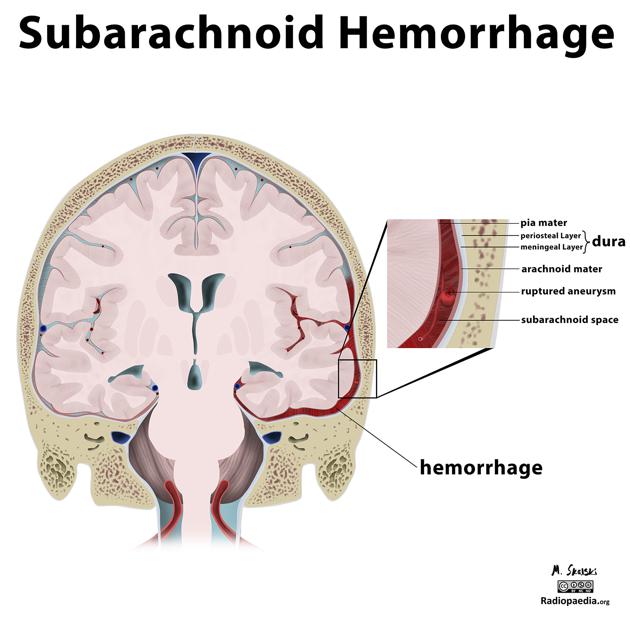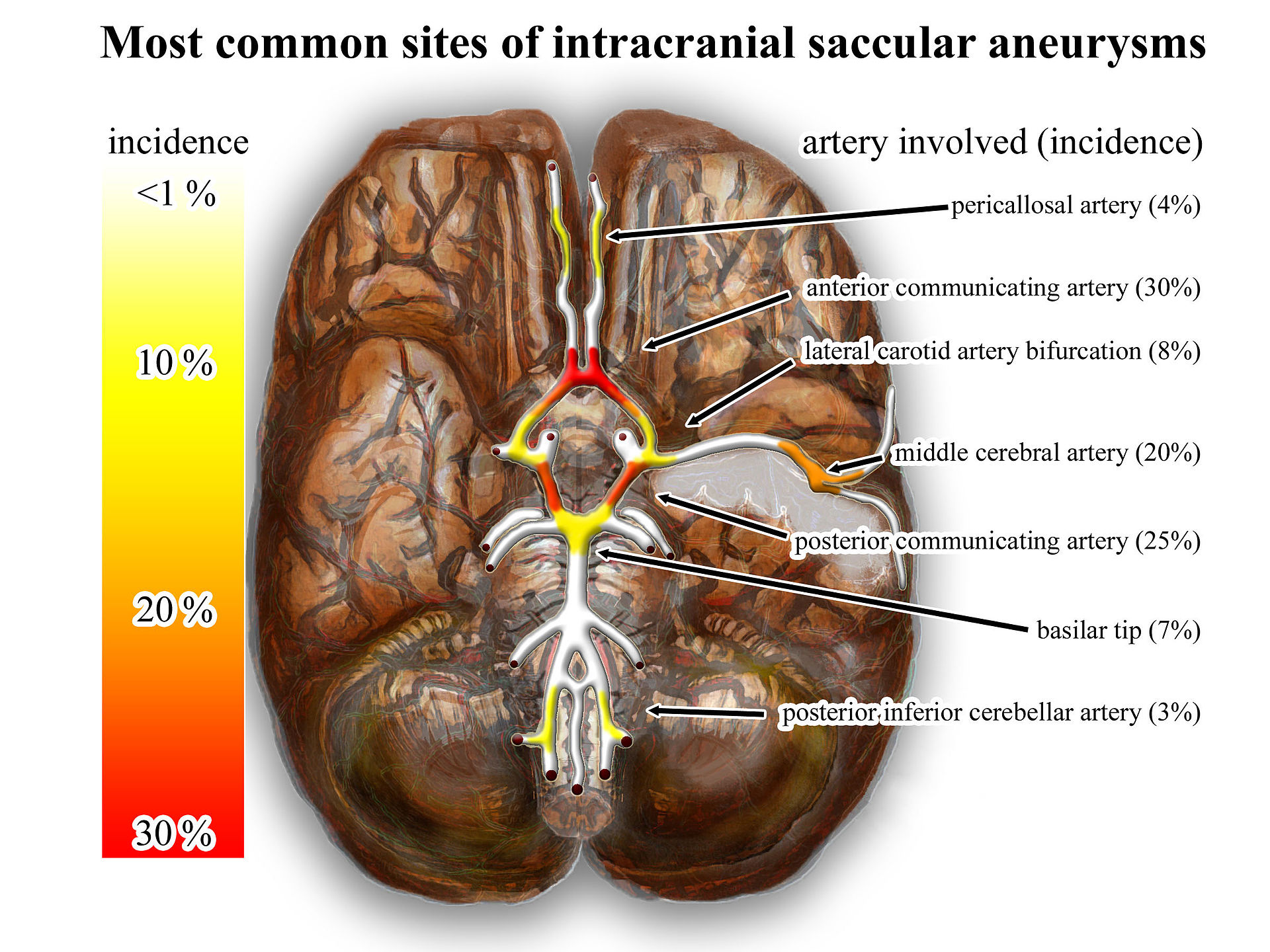Subarachnoid hemorrhage pathophysiology
|
Subarachnoid Hemorrhage Microchapters |
|
Diagnosis |
|---|
|
Treatment |
|
AHA/ASA Guidelines for the Management of Aneurysmal Subarachnoid Hemorrhage (2012)
|
|
Case Studies |
|
Subarachnoid hemorrhage pathophysiology On the Web |
|
American Roentgen Ray Society Images of Subarachnoid hemorrhage pathophysiology |
|
Risk calculators and risk factors for Subarachnoid hemorrhage pathophysiology |
Editor-In-Chief: C. Michael Gibson, M.S., M.D. [1]; Associate Editor(s)-in-Chief: Syed Ahsan Hussain, M.D.[2] Sara Mehrsefat, M.D. [3]
Overview
Subarachnoid hemorrhage (SAH) is the result of the bleeding within the subarachnoid space, which is filled with cerebrospinal fluid. It is a bleeding which is accumulated between the arachnoid and pia mater and can spread into intraventricular space, brain parenchyma and subdural space.[1] Excluding head trauma, sub arachnid hemorrhage mainly results from spontaneous rupture of a saccular aneurysm.[2] The exact pathogenesis of nonaneurysmal SAH (NASAH) is not fully understood. It is though that the mechanism of the bleeding in this type of subarachnoid hemorrhage is diverse. One of the most common subtype is called perimesencephalic nonaneurysmal subarachnoid hemorrhage (PM NASAH). It is characterized as localized specific blood pattern on computed tomography (CT), normal cerebral angiography, and less sever symptoms and course of the condition.[3]
Pathophysiology

Subarachnoid hemorrhage (SAH) is the result of the bleeding within the subarachnoid space, which is filled with cerebrospinal fluid. It is a bleeding which is accumulated between the arachnoid and pia mater and can spread into intraventricular space, brain parenchyma and subdural space.[1] Excluding head trauma, sub arachnid hemorrhage mainly results from spontaneous rupture of a saccular aneurysm.[2]
Aneurysmal subarachnoid hemorrhage
Spontaneous subarachnoid hemorrhage can be a result of the aneurysmal rupture:[1][2][4][5]
- Saccular aneurysms (responsible for most SAHs)
- Fusiform aneurysms (dilatation of the entire circumference of the vessel that may in part be formed due to atherosclerosis)
- Mycotic aneurysms (infected emboli due to infective endocarditis)
Saccular aneurysms
Saccular (berry) aneurysms are responsible for most cases of subarachnoid hemorrhage (SAH). Multiple factors play a role in formation of a saccular aneurysms. Saccular aneurysms usually results from degenerative change in the vessel wall following:[2]
- Hemodynamic stress (turbulent blood flow) which it may result in excessive tear and breakdown of the internal elastic lamina which it progress to lack of elastic lamina.
It is also thought that inflammatory process is also play a role in pathogenesis of aneurysms.[4][6]

Common associated conditions may include:[8][9][10]
The role for genetic factors in pathogenesis of aneurysmal formation has been approved. However, the exact pathogenesis remains unknown. It is thought that some connective tissue disease may result in arterial wall weakness and non-laminar flow pattern of blood, which is then progress to tear and breakdown of the wall.[9][10] Additionally, it is thought concurrent hypertension may play a role in patient with autosomal dominant polycystic kidney disease (PKD).[11]
Occult aneurysm
It is thought that negative angiogram following subarachnoid hemorrhage can be observed in almost 25% of all cases. As a result even two negative angiograms result can not exclude aneurysmal subarachnoid hemorrhage.[12][13][14]
Common reasons for having negative result in aSAH may include:[12][14][15]
- Technical errors
- Hematoma
- Aneurysm thrombosis
- Vasospasm
- Small aneurysm size
- Aneurysm obscuration
Histopathologic findings
Unruptured aneurysms wall may present with complete absence of endothelial lining.
However, ruptured aneurysm walls may present with Inflammatory cells (T cell and macrophage infiltration) in addition to complete absence of endothelial lining.
Histological types of aneurysm walls may be identified as follow:[16]
| Histological types | Consecutive stages of aneurysm walls | Chance of aneurysmal rupture |
|---|---|---|
| Type A |
|
|
| Type B |
|
|
| Type C |
|
|
| Type D |
|
|
Nonaneurysmal subarachnoid hemorrhage
The exact pathogenesis of nonaneurysmal SAH (NASAH) is not fully understood. It is though that the mechanism of the bleeding in this type of subarachnoid hemorrhage is diverse.
Perimesencephalic nonaneurysmal subarachnoid hemorrhage
perimesencephalic nonaneurysmal subarachnoid hemorrhage (PM NASAH) is characterized as localized specific blood pattern on computed tomography (CT), normal cerebral angiography, and less sever symptoms and course of the condition.[3][17][18]
The exact pathogenesis of perimesencephalic nonaneurysmal subarachnoid hemorrhage (PM NASAH) is not fully understood. However the three possible hypothesis may be as following:[17][19][20]
- Perforating artery disease: Because of the specific location which PM NASAH occurs, rupture of perforating artery arising from the posterior circulation can be a possible theory.
- Venous source: Because of a low rate of rebleeding and low pressure bleeding, It is thought that PM NASAH happens in the setting of of venus leakage.
- Basilar artery abnormalities: It can be secondary to intramural hematoma or possible vasospasm
Possible associated conditions may include:[21][20][22][23]
- Hypertension
- Acute lacunar infarctions
- Physical exertion
Vascular malformations
Spinal or intracranial vascular malformations may also result in subarachnoid hemorrhage. Instead of a brain parenchyma where normally vascular malformation occurs. Vascular lesion may also primarily occurs in the subarachnoid space and result in subarachnoid hemorrhage.[24][25]
Vascular malformations may include:[24][25][26][27]
- Arteriovenous malformation (AVM): Abnormal connection between arteries and veins in the brain and can result in vessels break and bleed into the brain.
- Dural arteriovenous fistulae
Intracranial arterial dissection
Dissection of an intracranial artery begins as a tear in the arterial wall. It is usually transverse and extends through the intima and halfway through the media and then create the false-lumen. In this setting, it usually result into thrombus formation, and thromboembolic stroke. If dissection extends through the adventitia, it may result in subarachnoid hemorrhage.[24][28][29]
References
- ↑ 1.0 1.1 1.2 STEHBENS WE (1963). "ANEURYSMS AND ANATOMICAL VARIATION OF CEREBRAL ARTERIES". Arch Pathol. 75: 45–64. PMID 14087271.
- ↑ 2.0 2.1 2.2 2.3 Austin G, Fisher S, Dickson D, Anderson D, Richardson S (1993). "The significance of the extracellular matrix in intracranial aneurysms". Ann Clin Lab Sci. 23 (2): 97–105. PMID 7681275.
- ↑ 3.0 3.1 van Gijn J, van Dongen KJ, Vermeulen M, Hijdra A (1985). "Perimesencephalic hemorrhage: a nonaneurysmal and benign form of subarachnoid hemorrhage". Neurology. 35 (4): 493–7. PMID 3982634.
- ↑ 4.0 4.1 Schievink WI, Karemaker JM, Hageman LM, van der Werf DJ (1989). "Circumstances surrounding aneurysmal subarachnoid hemorrhage". Surg Neurol. 32 (4): 266–72. PMID 2675363.
- ↑ Patel RL, Richards P, Chambers DJ, Venn G (1991). "Infective endocarditis complicated by ruptured cerebral mycotic aneurysm". J R Soc Med. 84 (12): 746–7. PMC 1295527. PMID 1774755.
- ↑ Aoki T, Nishimura M (2010). "Targeting chronic inflammation in cerebral aneurysms: focusing on NF-kappaB as a putative target of medical therapy". Expert Opin Ther Targets. 14 (3): 265–73. doi:10.1517/14728221003586836. PMID 20128708.
- ↑ Wikimedia, Subarachnoid_hemorrhage https://commons.wikimedia.org/wiki/Category:Subarachnoid_hemorrhage#/media/File:Wikipedia_intracranial_aneurysms_-_inferior_view_-_heat_map.jpg
- ↑ Starke RM, Chalouhi N, Ali MS, Jabbour PM, Tjoumakaris SI, Gonzalez LF; et al. (2013). "The role of oxidative stress in cerebral aneurysm formation and rupture". Curr Neurovasc Res. 10 (3): 247–55. PMC 3845363. PMID 23713738.
- ↑ 9.0 9.1 Pepin M, Schwarze U, Superti-Furga A, Byers PH (2000). "Clinical and genetic features of Ehlers-Danlos syndrome type IV, the vascular type". N Engl J Med. 342 (10): 673–80. doi:10.1056/NEJM200003093421001. PMID 10706896.
- ↑ 10.0 10.1 Neil-Dwyer G, Bartlett JR, Nicholls AC, Narcisi P, Pope FM (1983). "Collagen deficiency and ruptured cerebral aneurysms. A clinical and biochemical study". J Neurosurg. 59 (1): 16–20. doi:10.3171/jns.1983.59.1.0016. PMID 6864273.
- ↑ Vlak MH, Algra A, Brandenburg R, Rinkel GJ (2011). "Prevalence of unruptured intracranial aneurysms, with emphasis on sex, age, comorbidity, country, and time period: a systematic review and meta-analysis". Lancet Neurol. 10 (7): 626–36. doi:10.1016/S1474-4422(11)70109-0. PMID 21641282.
- ↑ 12.0 12.1 Jung JY, Kim YB, Lee JW, Huh SK, Lee KC (2006). "Spontaneous subarachnoid haemorrhage with negative initial angiography: a review of 143 cases". J Clin Neurosci. 13 (10): 1011–7. doi:10.1016/j.jocn.2005.09.007. PMID 16931020.
- ↑ Urbach H, Zentner J, Solymosi L (1998). "The need for repeat angiography in subarachnoid haemorrhage". Neuroradiology. 40 (1): 6–10. PMID 9493179.
- ↑ 14.0 14.1 du Mesnil de Rochemont R, Heindel W, Wesselmann C, Krüger K, Lanfermann H, Ernestus RI; et al. (1997). "Nontraumatic subarachnoid hemorrhage: value of repeat angiography". Radiology. 202 (3): 798–800. doi:10.1148/radiology.202.3.9051036. PMID 9051036.
- ↑ Rinkel GJ, Wijdicks EF, Hasan D, Kienstra GE, Franke CL, Hageman LM; et al. (1991). "Outcome in patients with subarachnoid haemorrhage and negative angiography according to pattern of haemorrhage on computed tomography". Lancet. 338 (8773): 964–8. PMID 1681340.
- ↑ Frösen J, Piippo A, Paetau A, Kangasniemi M, Niemelä M, Hernesniemi J; et al. (2004). "Remodeling of saccular cerebral artery aneurysm wall is associated with rupture: histological analysis of 24 unruptured and 42 ruptured cases". Stroke. 35 (10): 2287–93. doi:10.1161/01.STR.0000140636.30204.da. PMID 15322297.
- ↑ 17.0 17.1 Schwartz TH, Solomon RA (1996). "Perimesencephalic nonaneurysmal subarachnoid hemorrhage: review of the literature". Neurosurgery. 39 (3): 433–40, discussion 440. PMID 8875472.
- ↑ Rinkel GJ, Wijdicks EF, Vermeulen M, Ramos LM, Tanghe HL, Hasan D; et al. (1991). "Nonaneurysmal perimesencephalic subarachnoid hemorrhage: CT and MR patterns that differ from aneurysmal rupture". AJNR Am J Neuroradiol. 12 (5): 829–34. PMID 1950905.
- ↑ Alén JF, Lagares A, Lobato RD, Gómez PA, Rivas JJ, Ramos A (2003). "Comparison between perimesencephalic nonaneurysmal subarachnoid hemorrhage and subarachnoid hemorrhage caused by posterior circulation aneurysms". J Neurosurg. 98 (3): 529–35. doi:10.3171/jns.2003.98.3.0529. PMID 12650424.
- ↑ 20.0 20.1 Peeva-Gjuleva D, Fedorov JA, Dmitriev IM (1975). "[Radioisotope investigation of the cariostatic effect of Hisar mineral water]". Stomatologiia (Sofiia). 57 (2): 106–14. PMID 1075747.
- ↑ Schwartz TH, Solomon RA (1996). "Perimesencephalic nonaneurysmal subarachnoid hemorrhage: review of the literature". Neurosurgery. 39 (3): 433–40, discussion 440. PMID 8875472.
- ↑ Tatter SB, Buonanno FS, Ogilvy CS (1995). "Acute lacunar stroke in association with angiogram-negative subarachnoid hemorrhage. Mechanistic implications of two cases". Stroke. 26 (5): 891–5. PMID 7740585.
- ↑ Matsuyama T, Okuchi K, Seki T, Higuchi T, Murao Y (2006). "Perimesencephalic nonaneurysmal subarachnoid hemorrhage caused by physical exertion". Neurol Med Chir (Tokyo). 46 (6): 277–81, discussion 281-2. PMID 16794347.
- ↑ 24.0 24.1 24.2 Rinkel GJ, van Gijn J, Wijdicks EF (1993). "Subarachnoid hemorrhage without detectable aneurysm. A review of the causes". Stroke. 24 (9): 1403–9. PMID 8362440.
- ↑ 25.0 25.1 Cordonnier C, Al-Shahi Salman R, Bhattacharya JJ, Counsell CE, Papanastassiou V, Ritchie V; et al. (2008). "Differences between intracranial vascular malformation types in the characteristics of their presenting haemorrhages: prospective, population-based study". J Neurol Neurosurg Psychiatry. 79 (1): 47–51. doi:10.1136/jnnp.2006.113753. PMID 17488785.
- ↑ Halbach VV, Higashida RT, Hieshima GB, Goto K, Norman D, Newton TH (1987). "Dural fistulas involving the transverse and sigmoid sinuses: results of treatment in 28 patients". Radiology. 163 (2): 443–7. doi:10.1148/radiology.163.2.3562824. PMID 3562824.
- ↑ Kandel EI (1980). "Complete excision of arteriovenous malformations of the cervical cord". Surg Neurol. 13 (2): 135–9. PMID 7355376.
- ↑ Santos-Franco JA, Zenteno M, Lee A (2008). "Dissecting aneurysms of the vertebrobasilar system. A comprehensive review on natural history and treatment options". Neurosurg Rev. 31 (2): 131–40, discussion 140. doi:10.1007/s10143-008-0124-x. PMID 18309525.
- ↑ Zhao WY, Krings T, Alvarez H, Ozanne A, Holmin S, Lasjaunias P (2007). "Management of spontaneous haemorrhagic intracranial vertebrobasilar dissection: review of 21 consecutive cases". Acta Neurochir (Wien). 149 (6): 585–96, discussion 596. doi:10.1007/s00701-007-1161-x. PMID 17514349.